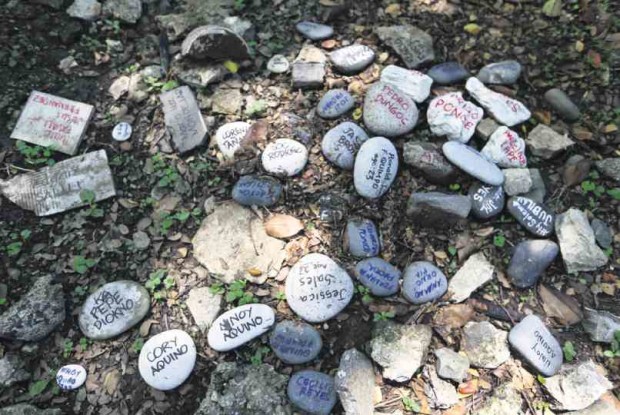
THROUGH the #bawatbato movement launched at the Libingan ng mga Bayani on Sunday, anti-Marcos groups hope to send a strong message to President-elect Rodrigo Duterte: The late dictator does not deserve a hero’s burial. LYN RILLON
Liliosa Hilao, Edgar Jopson, Ninoy Aquino, Archimedes Trajano, Dr. Juan Escandor and Sen. Jose W. Diokno.
These were among the martial law victims whose names had been written on stones that were placed on a plot at the Libingan ng mga Bayani in Taguig City, where the late strongman Ferdinand Marcos Sr., was expected to be laid to rest.
The activity was in line with Sunday’s launching of the #bawatbato (each stone) movement by groups opposed to President-elect Rodrigo Duterte’s decision to finally let Marcos be buried at the cemetery.
“We believe the martial law heroes and martyrs whose names were written on the stones deserve more of a hero’s burial than Marcos,” Susan Quimpo, member of the Martial Law Chronicles Project, told the Inquirer on Tuesday.
The idea of using stones as a foundation of dissent was conceived by writer Miguel Syjuco of the Bantayog ng mga Bayani Foundation, Quimpo said.
During Sunday’s event, members of Bantayog, Martial Law Chronicles, University of the Philippines Samasa alumni, Claimants 1081, and Nameless Heroes and Martyrs went to the cemetery to place their stones on Marcos’ supposed grave site.
Members of Akbayan Youth, Dakila and Filipino Freethinkers also participated.
Quimpo, author of “Subversive Lives: A Family Memoir of the Marcos Years,” placed stones bearing the names of her brothers, Ishmael “Jun” and Ronald “Jan,” who were detained and tortured during martial law. Jan disappeared without a trace while Jun, a student activitist who later joined the New People’s Army, was killed in Nueva Ecija province.
According to Quimpo, the initial laying of stones was “symbolic” as the movement encouraged others to do the same in different sites significant in the struggle against the dictatorship. These may include schools where many students were detained or killed, she said.
“We want people to take pictures and upload it on social media as part of the plea to President Duterte to stop the hero’s burial,” she added.
For members of the #bawatbato movement, burying Marcos at the Libingan ng mga Bayani would be an insult to the memory of martial law victims.
“It would not bring closure and unity. It would be disruptive. Perhaps the best thing to do is bury him (Marcos) in Ilocos, where he is loved and revered,” Quimpo said.
At the moment, Marcos’ preserved body is encased in a glass coffin and kept on public display at the Marcos Museum and Mausoleum in Batac, Ilocos Norte.
His supposed burial plot at Section A of the Libingan ng mga Bayani, an area reserved for the country’s former presidents, was prepared during the term of President Joseph Estrada who also favored Marcos’ interment at the cemetery.
Estrada, now Manila mayor, confirmed that he agreed to a hero’s burial for Marcos but it did not push through because of his ouster from office.
His stand, however, has not changed as he told the Inquirer on Tuesday: “We should be forgiving and we should respect the dead.”
Duterte earlier said that he would let Marcos be laid to rest at the Libingan ng mga Bayani as the issue has long divided the nation. His pronouncement, however, has been opposed by victims of human rights abuses during the martial law period.